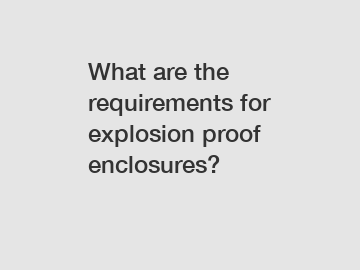What are the requirements for explosion proof enclosures?
What are the requirements for explosion-proof enclosures?
Explosion-proof enclosures play a critical role in keeping hazardous environments safe. Whether it's in a chemical plant, an oil refinery, or a mining site, these enclosures serve as a safeguard against potential explosions that could cause severe damage to both life and property. In order to understand the requirements for explosion-proof enclosures, let's discuss a few key points.
1. Material and Construction:

One of the fundamental requirements for explosion-proof enclosures is their construction and the materials used. These enclosures are specifically designed to withstand potentially explosive environments. They are typically made from robust materials such as stainless steel or aluminum. The thickness of the enclosure's walls and the quality of the seals are crucial factors to ensure containment of potentially explosive gases or dust.
2. Certification and Standards:
There are several internationally recognized certifications and standards that explosion-proof enclosures must adhere to. The most prominent standard is the National Electrical Code (NEC) in the United States and the International Electrotechnical Commission's (IEC) standards globally. These certifications ensure that the enclosures meet specific safety requirements and have been tested and approved to contain or prevent an explosion.
3. Proper Ventilation:
Explosion-proof enclosures must be designed with an effective ventilation system. While it may seem counterintuitive to allow ventilation in an enclosure designed to prevent explosions, it is crucial. The ventilation system helps to maintain a controlled environment by preventing the buildup of potentially hazardous gases, ensuring effective ventilation to dissipated heat, and creating a safe working atmosphere.
4. Electrical Components and Wiring:
Given that explosion-proof enclosures often house electrical equipment, it is vital that the internal components meet specific requirements to prevent sparks or arcs that could trigger an explosion. Electrical connections within the enclosures must be securely sealed to prevent any fire or explosion hazards. All electrical components used inside these enclosures should comply with the necessary explosion-proof standards.
Explosion-proof enclosures are subject to rigorous testing procedures to ensure their safety and effectiveness. These tests simulate various conditions such as extreme temperatures, pressure differentials, and ingress of dust or moisture. The enclosures must pass these tests and demonstrate their ability to prevent explosion propagation effectively.
An explosion-proof enclosure protects not only the enclosed equipment but also the surrounding environment. By isolating any potential explosion within the enclosure, these safety measures prevent a chain reaction and thus minimize the danger to personnel and property.
In conclusion, the requirements for explosion-proof enclosures are multifaceted and comprehensive. They encompass the materials and construction of the enclosure, adherence to recognized standards and certifications, the provision of proper ventilation, and the use of suitable electrical components and wiring. Adhering to these requirements ensures that the enclosures can effectively contain any explosions and protect personnel and property in hazardous environments.
If you are looking for more details, kindly visit weatherproof fluorescent light fixture, explosion proof panels, explosion proof cable.

Comments
0